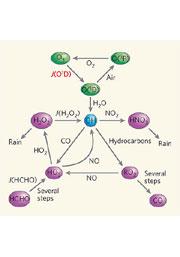 The atmospheric chemistry of air-cleansing OH radicals is very complicated.
The atmospheric chemistry of air-cleansing OH radicals is very complicated.We may be flooding the air with pollutants, but the 'atmospheric detergent' that mops them up is still going strong, according to research in this week's Nature1. That's because the amount of cleanser in our skies seems to depend on ultraviolet radiation coming from the Sun, rather than the amount of pollution it has to clean.
Earth's lower atmosphere (or troposphere) benefits from a thorough self-cleaning regime that removes pollutants such as nitrogen oxides, methane and carbon monoxide. The cleaning agent responsible is the hydroxyl radical (denoted 'OH'), which is created when ultraviolet radiation splits apart a molecule of ozone to produce oxygen atoms that subsequently react with water. The resulting hydroxyl radicals are highly active and quickly react with trace atmospheric gases, such as the pollutant carbon monoxide, which is rapidly turned into carbon dioxide.
The big question is whether we can rely on hydroxyl's cleansing power, or whether the pollutants are using it up. It has proved hard to answer this question by measuring OH levels, as the radicals last for only a second before they react, and they are typically found in minute concentrations. But researchers have overcome this technical challenge, directly measuring the amount of atmospheric hydroxyl over a period of five years.
“Nobody could believe it when we got this result.”
Franz Rohrer,
Jülich Research Centre, Germany
The study, based at the Hohenpeissenberg Meteorological Observatory in southern Germany, found that the amount of hydroxyl in the sky did not change significantly from one year to the next. "There is no long-term trend in the level of OH," the researchers write. It seems there is still plenty of atmospheric detergent left.
But the good news is tempered with a warning. As co-author Franz Rohrer of the Jülich Research Centre explains, the observations also show that atmospheric chemists don't fully understand the complex reactions that control the generation and destruction of hydroxyl radicals in our atmosphere.
Reduce, reuse, recycle
Although hydroxyl radicals are degraded by pollutants, says Rohrer, some of these same molecules also help to recycle OH. "It is a very complicated system. Chemical reactions are coupled together — they have knock-on effects. We try to understand each reaction separately, then put all the pieces together in a model and see what happens to the OH levels Óat the end of the system."
The researchers found, to their surprise, that the amount of hydroxyl in the atmosphere seems to depend only on the intensity of a specific band of ultraviolet radiation from the Sun (the same UVB radiation that creates a tan) — and nothing else. "Nobody could believe it when we got this result," says Rohrer. "There must be regulating processes that mean everything else in the chemical reaction system cancels out."
Previous researchers had indicated, from a few weeks' observation, that there was a strong link between hydroxyl concentrations and UV radiation, but it had not been possible to say whether that this relationship was stable over many years.
Worryingly, a simple check on the level of UVB radiation managed to predict OH concentrations more accurately than current, complex atmospheric models that take into account factors such as temperature, ozone and pollutants. "It is clear from these observations that we still don't have an adequate theory for the oxidative chemistry of the lower atmosphere," says Paul Wennberg, an atmospheric chemist at the California Institute of Technology in Pasadena.
While the sun shines
ADVERTISEMENT
Still, the research has simplified the problem of measuring hydroxyl levels. It should now be possible to create an 'OH index' based on UVB radiation measurements. This will make it easier for researchers to track long-term trends in the amount of the atmospheric detergent.
What will happen to hydroxyl concentrations in the future? That could depend on the status of Earth's protective ozone layer, which shields us from UVB, notes Martin Wild, an atmospheric scientist at the Swiss Federal Institute of Technology in Zurich. According to a recent review in Nature, ozone levels in the past decade have levelled off, and look set to increase thanks to reductions in ozone-eating pollutants2. So for the moment, our air-cleaning mechanism is operating well; but hydroxyl levels could change as the ozone layer thickens.
Visit our helpscleanthesky.html">newsblog to read and post comments about this story.
Jülich Research Centre, Germany
